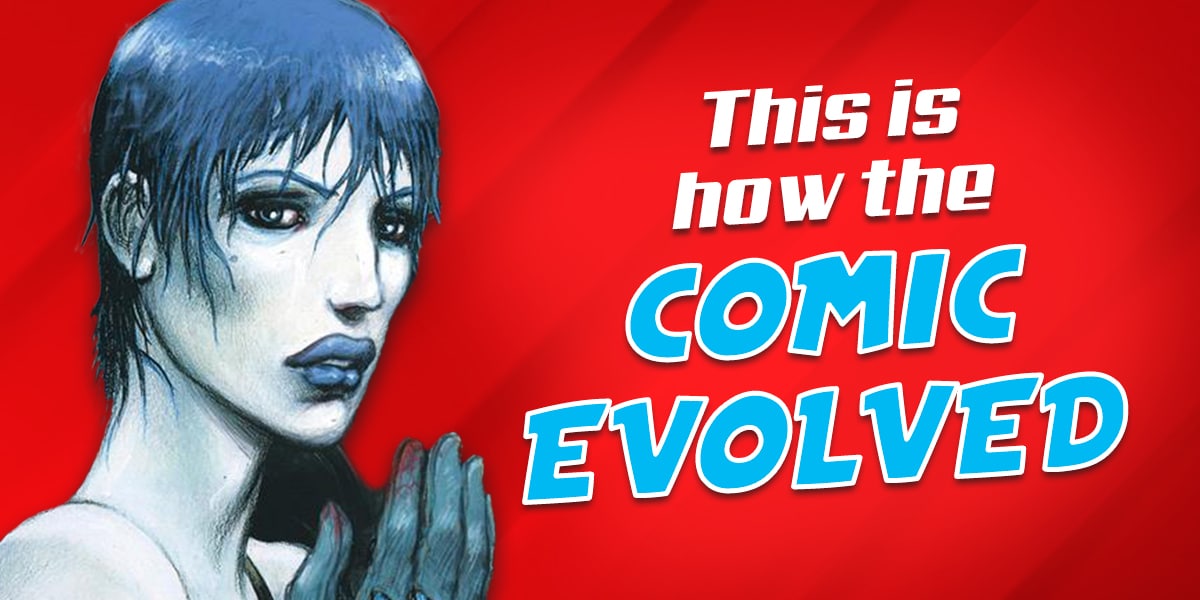The Evolution of Comics: A Journey Through Time and Imagination
Have you ever wondered how those characters that have accompanied us since childhood came to be? Where do those panels come from that transport us to fantastic worlds with just the turn of a page? Get ready to embark on a fascinating journey through the history of comics, from their humble origins in prehistoric caves to today’s digital screens. We’ll discover how this art form has evolved, reflecting and shaping our culture over the centuries. Grab your detective’s magnifying glass and join us on this graphic adventure!
From Caves to Pages: The Dawn of Comics
Imagine for a moment our ancestors, 14,000 years ago, capturing their hunting exploits on cave walls. These early “artists” didn’t know it, but they were laying the foundations for what we now know as comics. Using charcoal from their fires, they created sequences of images that told stories, the oldest precursor to our beloved comic panels.
But the path from those caves to our modern comics was long and winding. Thousands of years had to pass before humanity developed the techniques and technologies necessary to create comics on paper. The first manifestations of what we might consider “proto-comics” emerged as social and political satires, usually in the form of single illustrations that captured specific moments of contemporary reality.
The big leap came in 1809, when Thomas Rowlandson published “The Tours of Dr. Syntax”. This work is considered by many as the true birth of the modern comic, as it presented for the first time a sequential narrative with continuity between images. Rowlandson wasn’t just drawing; he was writing a new visual language that would forever change the way we tell stories.
Inspired by Rowlandson, other artists began to experiment with this new medium. In 1897, “The Katzenjammer Kids” became the first serialized comic strip, appearing regularly in The New York Journal. This series, which narrated the mischief of two brothers and their mother, marked the beginning of a new era in which comic characters would become an integral part of popular culture.
The next milestone came in 1907 with Bud Fisher’s “Mutt and Jeff”, the first comic strip published daily in a newspaper. This daily format allowed readers to follow the adventures of their favorite characters with unprecedented frequency, creating a stronger bond between the audience and the stories. The longevity of “Mutt and Jeff”, which was published until 1982, is a testament to how deeply a comic can become rooted in the collective consciousness.

In 1910, the world of comics took another giant step with the launch of “The Funniest”, the first magazine dedicated exclusively to comic strips. This monthly publication not only consolidated comics as an entertainment medium in its own right, but also paved the way for “Funnies on Parade”, the first comic book as we know it today.
It’s fascinating to think about how these early works laid the foundation for everything that would come after. From the superheroes that would dominate the 20th century to the underground comics that would challenge social conventions, everything has its roots in these pioneers. Want to explore more about the origins of comics and how they have influenced current art? Discover fascinating resources here.
The Golden Age: When Superheroes Conquered the World
With the groundwork laid by the pioneers, comics were ready for their next big revolution: the era of superheroes. This era, which began in the 1930s and extended until the late 1950s, saw the birth of some of the most iconic characters in pop culture.
It all started with the appearance of Superman in 1938. Created by Jerry Siegel and Joe Shuster, this alien with superhuman powers captured the public’s imagination and set the mold for the superheroes that would follow. Batman, Wonder Woman, Captain America, and many others soon joined the party, each bringing their own twist to the concept of the masked hero.
These new characters not only offered escapism during difficult times like the Great Depression and World War II, but also reflected the values and aspirations of American society. Superman embodied the ideal of the immigrant coming to America to do good, while Captain America represented patriotism and the fight against fascism.
The popularity of superhero comics was so overwhelming that they soon expanded beyond the printed page. Radio programs, film serials, and eventually television series brought these characters to new media, solidifying their place in popular culture.
But the Golden Age wasn’t limited to superheroes. Genres such as horror, crime, and science fiction also flourished during this period, offering a wide range of stories for all tastes. EC Comics, with its famous series like “Tales from the Crypt” and “Weird Science”, took comic art to new heights of narrative and visual sophistication.
However, this period of unbridled creativity was not without controversy. Concerns about violent and sexual content in comics led to the creation of the Comics Code Authority in 1954, a self-censorship system that would have a lasting impact on the industry.
Despite these restrictions, the Golden Age left an indelible legacy. The characters and concepts created during this time continue to inspire artists and writers to this day. Are you passionate about superhero art? Click here to discover how you can take your skills to the next level.
The Underground Revolution and the Medium’s Maturity
While superheroes dominated the mainstream market, a revolution was brewing on the margins. In the late 60s and early 70s, the underground comics movement shook the foundations of the industry, challenging conventions and exploring themes that the Comics Code Authority had banned.
Robert Crumb, with his magazine “Zap Comix”, became the standard-bearer of this movement. His characters, like Mr. Natural, not only broke with the stereotypes of traditional heroes but also offered a scathing critique of contemporary society. These comics addressed topics such as sexuality, drugs, and politics with a frankness that scandalized many and liberated others.
At the same time, in Europe, artists like Hugo Pratt were elevating comics to new artistic heights. His character Corto Maltese, introduced in 1967, demonstrated that comics could be sophisticated, literary, and aimed at an adult audience. Pratt fused adventure with philosophical reflection, creating a type of graphic narrative that influenced generations of creators.

The 1980s saw the emergence of what many consider the golden age of adult comics. Works like Alan Moore and Dave Gibbons’ “Watchmen”, and Frank Miller’s “The Dark Knight Returns”, deconstructed the superhero myth and explored complex themes such as politics, psychology, and the nature of power. These works not only changed the public perception of comics but also inspired a new generation of creators to explore the medium’s potential.
In France, bande dessinée reached new heights of sophistication with works like Enki Bilal’s Nikopol trilogy. Mixing science fiction, politics, and mythology, Bilal created a unique visual universe that challenged expectations of what a comic could be.
This maturation of the medium was not limited to the West. In Japan, manga was experiencing its own revolution. Artists like Osamu Tezuka, known as the “God of Manga”, were creating epic works spanning thousands of pages and exploring deeply human themes. Series like “Astro Boy” and “Black Jack” not only captivated Japanese readers but also laid the groundwork for manga’s global expansion.
The evolution of comics in this era demonstrated that the medium could address any topic and reach any audience. It was no longer just entertainment for children, but an art form capable of exploring the complexities of the human condition. Curious to explore these advanced narrative techniques? Enter here to discover resources that will help you elevate your art.
The Digital Era: New Horizons for the Ninth Art
With the arrival of the new millennium, the world of comics faced one of its greatest challenges and opportunities: the digital revolution. Technology not only changed how comics were created but also how they were distributed and consumed.
Artists began to adopt digital tools for their work. Graphics tablets, illustration software, and digital coloring became essential elements in many creators’ arsenals. This not only sped up the production process but also opened up new creative possibilities. Visual effects that were previously impossible or prohibitively expensive to achieve by hand were now within reach of any artist with a computer.
But the impact of technology went beyond creation. Digital distribution transformed the industry landscape. Digital comic platforms and reading apps allowed readers to access a vast library of titles with just a touch of a screen. This not only changed consumption habits but also democratized publishing, allowing independent creators to reach global audiences without the need for large publishers.
The webcomic format gained prominence, with series like “Penny Arcade” and “XKCD” building huge online fan bases. These comics not only explored new business models based on advertising and merchandising but also experimented with formats that took advantage of the possibilities of the digital medium, such as the “infinite scroll” or the incorporation of interactive elements.
Globalization facilitated by the internet also led to greater appreciation and mixing of styles from around the world. Japanese manga, which had already gained popularity in the West in previous decades, became even more accessible, strongly influencing artists worldwide. At the same time, European and American comics found new audiences in Asia and other previously difficult-to-penetrate markets.
Comics also began to expand beyond their traditional boundaries, merging with other media. The adaptation of comics to film and television reached new heights, with the Marvel Cinematic Universe becoming one of the biggest cultural phenomena of the 21st century. This not only brought comic book characters to a wider audience than ever before but also influenced how stories were told in comics, with many adopting a more “cinematic” approach to visual storytelling.
The digital era also saw the emergence of new genres and formats. Graphic novels, which had already gained respect in previous decades, consolidated as a respected literary form. Works like Marjane Satrapi’s “Persepolis” and Alison Bechdel’s “Fun Home” not only received critical acclaim but were also incorporated into academic curricula, solidifying the place of comics as a serious art form capable of addressing complex themes.
Despite these advances, the comics industry also faced challenges in the digital era. Piracy and the expectation of free content online posed problems for traditional business models. Many creators and publishers had to adapt, experimenting with subscription models, crowdfunding, and other innovative ways to monetize their work.
The future of comics in the digital era seems to be full of exciting possibilities. Augmented reality and virtual reality offer new ways to interact with stories. NFTs (non-fungible tokens) are opening new avenues for digital ownership and collecting. And artificial intelligence, although controversial, is beginning to play a role in the creation of art and narratives.
The Art of Scriptwriting: The Backbone of Comics
Throughout the evolution of comics, one element has remained constant and crucial: the script. Regardless of genre, style, or era, a good script is the foundation upon which every great graphic story is built. It’s the compass that guides characters through the world created by the artist, giving life and purpose to each panel.
The process of writing a comic script is an art in itself, requiring a unique ability to think in both words and images. Unlike writing for novels or films, the comic scriptwriter must consider how the narrative will be distributed across pages and panels, creating a visual rhythm that complements the story.
A good comic script should:
- Clearly establish the plot and characters
- Create natural and effective dialogues
- Describe actions and scenes in a way that the artist can visualize
- Balance text and images for fluid storytelling
- Maintain rhythm and tension throughout the story
Comic scriptwriters work closely with artists, creating a unique synergy between words and images. This collaboration is fundamental to bringing characters and the world they inhabit to life. Want to perfect the art of writing comic scripts? Discover valuable resources here.
The Visual Language of Comics: Beyond Words
Comics are not just about telling stories with words and images; they have developed their own unique visual language over the years. This language includes elements such as:
Panels: These rectangular frames are the basic unit of narration in comics. Each panel captures a specific moment in time and action, and the sequence of panels creates the narrative flow.
Speech bubbles: These spaces, usually oval or rectangular with a tail pointing to the speaker, contain the characters’ dialogues. The shape and style of the bubble can indicate the tone of voice or emotional state of the speaker.
Narration boxes: These rectangles, usually at the top or bottom of a panel, contain narrative text that is not dialogue, such as scene descriptions or narrator thoughts.
Onomatopoeias: These textual representations of sounds (like “BAM!” or “CRASH!”) add an auditory dimension to the visual experience of comics.
Motion lines: These dynamic lines indicate the direction and speed of movement, adding action and energy to static images.
Visual metaphors: Symbols like light bulbs for ideas or hearts for love communicate abstract concepts quickly and effectively.
Mastering this visual language is essential for any comic artist. It allows for communicating emotions, actions, and concepts efficiently and effectively, often without the need for words. Eager to master the visual language of comics? Click here to access resources that will help you perfect these techniques.
The Future of Comics: Innovation and Tradition
As we move further into the 21st century, the world of comics continues to evolve and adapt. Technology continues to play a crucial role in this evolution, but we also see a renewed appreciation for traditional techniques and the craftsmanship of the medium.
Some trends that are shaping the future of comics include:
Augmented reality and interactive comics: AR technology is allowing creators to add additional layers of interactivity to printed comics, blurring the line between physical and digital.
Comics on social media: Platforms like Instagram and TikTok are becoming new mediums for telling stories in comic format, reaching broader and more diverse audiences.
Diversity and inclusion: There is a growing emphasis on telling stories by and about traditionally underrepresented groups, enriching the comic landscape with new voices and perspectives.
Experimentation with formats: Creators are playing with new ways of structuring and presenting visual narratives, from infinite scroll comics to virtual reality experiences.
Crossmedia and transmedia: Comics are increasingly integrated into broader narrative ecosystems that span multiple media, from movies and TV series to video games and beyond.
Despite these technological advances, the heart of comics remains the same: telling compelling stories through the unique combination of words and images. The ability to draw, narrate, and connect with the reader remains as crucial as ever.
The future of comics is bright and full of possibilities. Whether you find yourself drawing on a digital tablet or perfecting your hand-inking technique, there’s a place for you in this exciting medium. Ready to be part of the future of comics? Discover how you can take your skills to the next level here.
Conclusion: Comics, an Art in Constant Evolution
From cave walls to the screens of our mobile devices, comics have come a long way. They have evolved from simple humorous strips to complex graphic novels, from one-dimensional superheroes to deeply nuanced characters. They have reflected and shaped our culture, challenged conventions, and expanded the boundaries of what is possible in visual storytelling.
Throughout its history, comics have demonstrated time and again their ability to adapt and reinvent themselves. They have survived wars, censorship, technological changes, and cultural transformations. At each stage, they have emerged stronger and more diverse, finding new ways to connect with readers and tell stories that resonate with universal human experiences.
As we look to the future, it’s clear that comics will continue to evolve. New technologies will offer new possibilities, and social changes will inspire new stories and perspectives. But at the heart of it all will remain the fundamental magic of comics: their unique ability to combine words and images in ways that spark our imagination and transport us to other worlds.
Whether you’re an avid reader, an aspiring artist, or an experienced creator, the world of comics invites you to be part of its ongoing evolution. Every page you read, every line you draw, every story you tell, contributes to this dynamic and ever-changing art form.
So pick up your pencil, your tablet, or whatever you use to create, and join the adventure. The next chapter in the history of comics is waiting to be written, and you could be the one to write it.



